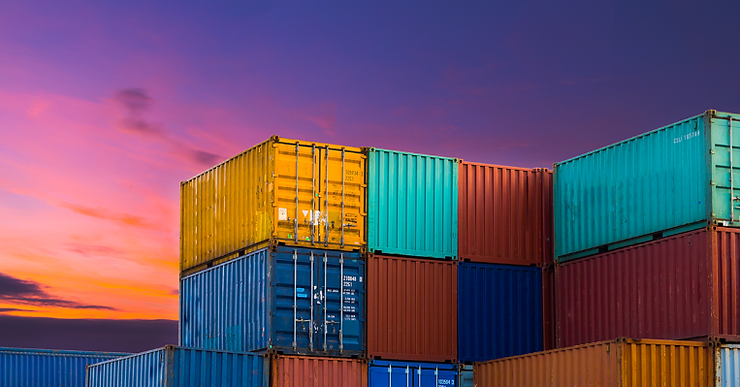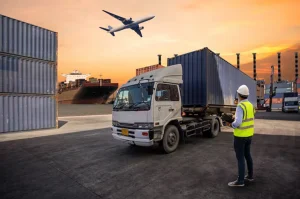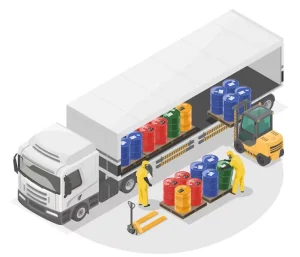The Significance of Standard Dimensions
Why do these standard dimensions matter? Let’s explore their crucial roles in the logistics ecosystem.
Efficiency in Transportation
Using standardized containers, pallets, and boxes ensures efficient utilization of cargo space in trucks, ships, and planes. This translates to fewer trips, reduced fuel consumption, and lower emissions—benefits for your business and the environment.
Compatibility in Warehousing
Warehouses are logistics hubs where space optimization is essential. Standardized pallet and box sizes make it easier to stack and organize goods, maximizing storage capacity and minimizing handling costs.
Cost Savings
Standard dimensions mean less manual labor and fewer errors in loading and unloading cargo. This efficiency translates into cost savings for your business, making logistics operations more economical.
International Logistics and Standardization
In the realm of international logistics, standardization plays a pivotal role in streamlining operations and ensuring the safe and timely delivery of goods.
Streamlining Supply Chains
A standardized approach simplifies supply chain management. It allows for better forecasting, reduces lead times, and minimizes the risk of errors during transfers between different transportation methods.
Enhancing Cargo Security
Knowing the precise dimensions of cargo containers and boxes helps ensure the security of goods during transit. It allows for better tracking and accountability throughout the logistics journey.
Standardized containers
Standardized containers, often referred to as shipping containers, are essential elements in modern logistics and international trade. These containers adhere to standardized dimensions and specifications, allowing for efficient and seamless transportation of goods across various modes of transportation, including ships, trucks, and trains.
Standardized Container Features:
1. Material: Standardized containers are typically constructed from steel, aluminum, or a combination of both. They are designed to withstand the rigors of international shipping and various weather conditions.
2. Sizes: The two most common standardized container sizes are the 20-foot container (TEU) and the 40-foot container (FEU). These containers have fixed lengths, widths, and heights, allowing for uniform stacking and handling.
-
20-Foot Container (TEU):
-
Length: 20 feet (6.06 meters)
-
Width: 8 feet (2.44 meters)
-
Height: 8.5 feet (2.59 meters)
-
-
40-Foot Container (FEU):
-
Length: 40 feet (12.19 meters)
-
Width: 8 feet (2.44 meters)
-
Height: 8.5 feet (2.59 meters)
-
3. High Cube Containers: These containers have the same lengths as standard 20-foot and 40-foot containers but are taller, with a height of 9.5 feet (2.89 meters).
4. Cargo Capacity: Standardized containers have specific weight and volume capacities, ensuring safe and efficient loading and transportation of goods.
5. Security Features: Most standardized containers come with locking mechanisms to secure cargo during transit, protecting it from theft and tampering.
Advantages of Standardized Containers:
-
Intermodal Compatibility: Standardized containers are designed to be compatible with various modes of transportation, including ships, trucks, and trains. This intermodal compatibility simplifies the transfer of goods between different transport systems.
-
Efficiency: Containers enable efficient loading, unloading, and stacking of goods, reducing handling time and costs. They maximize space utilization in ships, trucks, and storage facilities.
-
Security: Containers provide a high level of security for cargo. Once sealed, they are difficult to access, reducing the risk of theft and damage.
-
Protection: Containers protect cargo from external elements such as moisture, dust, and temperature variations, ensuring the integrity of goods during transit.
-
Standardization: The standardized dimensions and specifications of containers promote consistency and uniformity in the shipping industry, reducing errors and improving logistics operations.
-
Global Trade Facilitation: Standardized containers have played a significant role in facilitating global trade by simplifying the movement of goods across international borders.
Applications of Standardized Containers:
Standardized containers are widely used in various industries and for diverse cargo types, including:
-
Consumer goods and electronics
-
Industrial equipment and machinery
-
Automotive parts and vehicles
-
Agricultural products
-
Chemicals and hazardous materials
-
Food products, including refrigerated and frozen goods
Standardized Pallets
Standardized pallets, often referred to as pallets of standardized dimensions, are an essential component of material handling and logistics systems. These pallets adhere to standardized sizes and specifications, ensuring compatibility and efficiency in the movement and storage of goods.
Standardized Pallet Features:
1. Materials: Standardized pallets are typically made from wood, plastic, or metal. The choice of material depends on factors such as load capacity, durability, weight, and environmental considerations.
2.Sizes: Standardized pallets come in various sizes, but two of the most common sizes are:
-
ISO Standard Pallet (European): 800mm x 1200mm (31.5 inches x 47.2 inches).
-
North American Standard Pallet: 40 inches x 48 inches.
3. Styles: Pallets can have different styles, such as block pallets, stringer pallets, euro pallets, and nestable pallets. Each style offers specific advantages and is suitable for different types of products and handling equipment.
4. Load Capacity: Standardized pallets are rated for specific load capacities, including dynamic and static load ratings. These ratings indicate the pallet’s ability to support weight under various conditions.
Advantages of Standardized Pallets:
-
Compatibility: Standardized pallets are compatible with various handling and transportation equipment, including forklifts, pallet jacks, conveyors, and automated systems. This compatibility streamlines material handling operations.
-
Efficiency: Standardized pallet sizes are optimized for efficient use of space in storage facilities, transportation vehicles, and shipping containers. This can lead to cost savings in transportation and storage.
-
Protection: Pallets elevate goods above the ground, reducing the risk of damage from moisture, pests, and contaminants. They also facilitate the safe stacking of products.
-
Uniformity: Standardized pallets promote consistency in logistics operations, reducing errors and simplifying processes in supply chains.
-
Environmental Sustainability: Some standardized pallets are designed with sustainability in mind, using recycled materials or being recyclable themselves.
-
Customizability: While standardized pallets have set sizes, they can be customized with branding, labeling, and markings to meet specific product and industry requirements.
Applications of Standardized Pallets:
Standardized pallets are used in various industries and for diverse purposes, including:
-
Warehousing and distribution for storing and moving products within facilities.
-
Retail and grocery stores for displaying and transporting goods.
-
Manufacturing for transporting raw materials and finished products.
-
Transportation and logistics for loading goods onto trucks, ships, and trains.
-
Agriculture for handling and transporting produce.
Standardized Boxes
Standardized boxes, often referred to as corrugated boxes or cardboard boxes, are commonly used for packaging, shipping, and storing a wide range of goods. These boxes are designed and manufactured to meet standardized dimensions and specifications, ensuring consistency and compatibility within the logistics and supply chain industries.
Standardized Box Features:
-
Material: Standardized boxes are typically made from corrugated cardboard, which is a lightweight and durable material with good stacking strength and cushioning properties.
-
Sizes: Standardized boxes come in a variety of standard sizes to accommodate different types of products. Common sizes include 12x12x12 inches, 18x18x24 inches, 24x24x24 inches, and many others. These sizes are designed to fit efficiently on pallets and within shipping containers.
-
Styles: Standardized boxes can have various styles, including regular slotted containers (RSC), full overlap boxes, half-slotted containers (HSC), and more. Each style has specific advantages and is suitable for different types of products and packing methods.
-
Strength Ratings: Boxes are often rated based on their strength, including the bursting strength and edge crush test (ECT) ratings. These ratings indicate the box’s ability to withstand pressure and weight, helping to ensure the safe transportation of goods.
-
Flute Types: Corrugated cardboard comes in different flute types, such as A, B, C, E, and others. The flute type affects the strength and cushioning properties of the box.
Advantages of Standardized Boxes:
-
Consistency: Standardized boxes are consistent in size and design, making them compatible with various shipping and storage systems. This consistency streamlines logistics operations and reduces handling errors.
-
Efficiency: Standardized box sizes are optimized for efficient use of space in shipping containers, trucks, and warehouses. This can lead to cost savings in transportation and storage.
-
Protection: Corrugated cardboard provides good cushioning and protection for products during shipping and handling. It helps prevent damage and breakage.
-
Customizability: While standardized boxes have set sizes, they can be easily customized with printing, branding, and labeling to meet specific product and marketing requirements.
-
Cost-Effective: Standardized boxes are cost-effective due to their mass production and availability in the market.
Applications of Standardized Boxes:
Standardized boxes are used across various industries for packaging and shipping purposes, including:
-
E-commerce and retail for shipping products to customers.
-
Manufacturing and distribution for shipping raw materials and finished goods.
-
Food industry for packaging food products.
-
Electronics industry for packaging electronic devices and components.
-
Pharmaceuticals for shipping medicines and medical supplies.
-
Automotive industry for packaging automotive parts and components.
Toptrans: Your Logistics Partner
When it comes to standardized containers, pallets, and boxes, we go above and beyond to ensure your cargo is transported efficiently and securely. Here’s what we can offer you:
Standardized Container Solutions
Diverse Container Types:
-
Dry Containers: Versatile options for a wide range of cargo.
-
Refrigerated Containers: Specialized for temperature-sensitive goods.
-
Open-Top Containers: Ideal for top-loading oversized cargo.
-
Flat Rack Containers: Perfect for heavy and oversized items.
Various Container Sizes:
-
20-foot Container: Suitable for smaller shipments.
-
40-foot Container: Spacious for larger loads.
-
45-foot Container: Ideal for bulky cargo.
-
High Cube Containers: Accommodates taller goods.
Our commitment to standardized containers means that your cargo will seamlessly fit into our well-maintained fleet, ensuring efficient and cost-effective transportation.
Reliable Pallet Solutions
Pallet Variety:
-
Wooden Pallets: Traditional and widely used for stability.
-
Plastic Pallets: Durable and hygienic.
-
Metal Pallets: Ideal for heavy-duty applications.
-
Paper Pallets: Eco-friendly and lightweight.
Standard Pallet Sizes:
-
Euro Pallet: European standard (1200mm x 800mm).
-
Standard Pallet: Widely used in the U.S. and Asia (1200mm x 1000mm).
-
Half Pallet: For smaller shipments (600mm x 800mm).
-
Custom Pallets: Tailored to fit your unique cargo requirements.
With our range of pallet solutions, your cargo will be handled with the utmost care and precision, ensuring safe and efficient transport.
Customized Box Solutions
Box Flexibility:
-
Cardboard Boxes: Lightweight and cost-effective.
-
Wooden Crates: Sturdy and suitable for heavy items.
-
Plastic Boxes: Reusable and weather-resistant.
-
Corrugated Boxes: Ideal for fragile items.
Tailored Box Sizes:
-
Small Box: Compact items (approximately 16″ x 12″ x 12″).
-
Medium Box: Versatile for various goods (around 18″ x 18″ x 16″).
-
Large Box: Spacious for bulkier items (approximately 24″ x 18″ x 18″).
-
Custom Boxes: Designed to meet your cargo’s unique dimensions.
Our commitment to customized box solutions means your cargo will be protected throughout its journey, no matter its size or fragility.
So, when it comes to standardized containers, pallets, and boxes, TopTrans is your trusted logistics partner. Reach out to our customer service team for quick quotes and answers to any questions you may have. Your cargo’s journey starts with us, and we’re here to make it smooth, efficient, and cost-effective.








